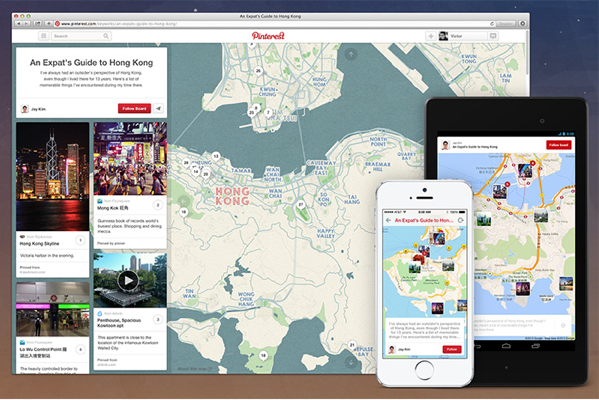We weren’t surprised to learn that Martha Stewart's Pinterest site gets ten times more traffic than her Facebook site. Why you may ask?
The short answer is that Pinterest is particularly attuned for certain kinds of companies, particularly those in the retail sector. It has a sleek and beautiful design that is mobile-friendly. And it has seemingly "cracked the e-commerce" code with its "rich pins," which allow users and content creators to include details specific to a pin's category. No one is more aware of this than Pinterest itself, which is why it's slowly expanding its empire with its recent launch of "Place Pins."
The roll-out of "Place Pins" present a new and irresistible channel for local business marketing.

What are "place pins?"
Pinterest has five types of "rich pins" — others include products, recipes, movies, articles, and now, "place pins" — which include details of a pin's category. And the new Place Pins, which is essentially a new Pinterest map tool, allows users to add Foursquare data to new or previously-pinned images, thereby tying them to a physical location. It allows users to boldly proclaim, "Here I am! No really, I'm like, right here at Pancho Villa, the Mexican restaurant (with the best salsa bar in the city, btw) in the Mission!" The Place Pin also includes the location's address and phone number.
What's Pinterest hoping to do with "Place Pins?"
They want to corner the travel planning market. The reasons are two-fold: one, users already use the platform for trip planning; the new place pins will make it easier for them. To quote Pinterest:
"Place Pins were designed to combine the beautiful imagery of a travel magazine with the utility of a map online so you can share it with friends. You can access them from anywhere on your smartphone, too, which means you can find new places on the go and even get directions! Place Pins also include extra details like the address and phone number right on the Pin so you can easily pull up useful info on a weekend adventure or before a night out."
And two, wily knock-offs have being doing the same thing for a while now; this new Pinterest map concept is trying to put them out of business.
OK, let's transition from the theoretical to the financial
Let's now try and take the concept of "pins" out of the theoretical and view them through the lens of the monetary. Pins, in a way, carry their own financial currency. Think about it: prospects using Place Pins are voluntarily telling marketers two of the most important elements to any sales exchange — their physical location the phone number of that location (never mind the fact that savvy marketers can also extract tons of valuable demographic insights from the user's profile.) This information is tremendously valuable; in fact, some analysts estimate a typical pin is equivalent to 78 cents in sales. Businesses should pay attention.
So how can local business capitalize on these nifty Place Pins?
Finally, the $64,000 question. This is still uncharted territory, but the opportunities for local businesses to utilize Place Pins to reach new customers are limitless. We suggest businesses do the following:
- Create a map to engage users. This can be done when you create a new board; at the bottom left is says, "Add a map?" Click Yes.
- Ask customers to "pin" their location on your map. It can be where customer lives or where they purchased a product. This will illustrate your company's broader reach to the world at large. Similarly, encourage them to pin photos of your product from their respective location.
- Create your own travel board. Pin your favorite locations on a map, whether its other small businesses or just places you like. Share the love and the love may be reciprocated (no guarantees, however. That's love for you.) This approach is particularly powerful for — you guessed it — travel companies. The Travel Channel, for example, created an "East Coast Beach Crawl" to help users plan their East Coast beach trip. The board includes beaches, hotels, restaurants, etc.
While the above approach may not suggest an immediate financial windfall, the map strengthens the Travel Channels brand, conveys their expertise, and establishes relationships with any pinned hotels and restaurants.
Aim to emulate the Travel Channel. If you're a car dealer, create a classic "road trip" map. A solar company? A "follow the sunset" trip. It's easy to do and a great way to get new prospects.





